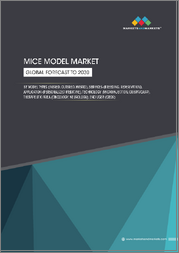
|
시장보고서
상품코드
1370712
맞춤형 의료용 나노재료 : 세계 시장Nanomaterials in Personalized Medicine: Global Markets |
||||||
세계 맞춤형 의료용 나노재료 시장 규모는 2023년 3,467억 달러에서 예측 기간 동안 11.3%의 CAGR을 나타내고, 2028년 말에는 5,920억 달러 규모로 성장할 것으로 예상됩니다.
제품 유형별로는 단백질 부문이 2023년 1,128억 달러에서 2028년 말 2,032억 달러 규모로 성장할 것으로 예상되며, 같은 기간 동안 12.5%의 CAGR을 나타낼 것으로 전망됩니다. 또한, 단일클론항체 부문은 2023년 780억 달러에서 2028년 말 1,364억 달러 규모로 11.8%의 CAGR을 나타내고, 성장할 것으로 예상됩니다.
세계 맞춤형 의료용 나노재료 시장을 조사했으며, 나노재료 및 기술 개요, 시장 영향요인 및 시장 기회 분석, 규제 환경, 시장 규모 추이 및 예측, 각 부문별/지역별 상세 분석, 기술 및 특허 동향, ESG 전개, 경쟁 구도, 주요 기업 개요, 주요 기업 프로파일 등의 정보를 전해드립니다.
목차
제1장 서론
- 나노 테라노스틱스 개요
- 폴리머 나노재료
- 자성 나노재료
- 실리카 기반 나노재료
- 카본 나노재료
- 복합 나노재료
- 생물 나노재료 : 항체·단백질·DNA
- 탄소나노튜브
- 기타 나노재료
- 다기능 나노재료
- 약물전달
- 본 조사의 목표와 목적
- 조사 범위
- 조사 방법
- 정보원
- 지역 구분
제2장 요약 및 하이라이트
- 시장 전망
- 시장 인사이트
제3장 시장 개요
- 시장 개요
- 테라노스틱스와 맞춤형 의료 : 개요
- 나노입자
- 패시브 타겟팅
- 액티브 타겟팅
- 나노테크놀러지 : 개요
- Size Definition
- Shape
- Surface Area
- Nanotheranostic Drug Delivery
- In Vivo Drug-Release Studies
- Drug Efficacy
- 향후 전망
제4장 진단 나노 디바이스와 나노재료
- 개요
- 진단 분자 인식
- 나노 패턴화 디바이스
- 입자
- 탄소나노튜브
- 면역 활성화합물, 단백질, 유전 물질 캐리어로서의 탄소나노튜브
- 암광열 요법
- 기타 치료 용도를 위한 탄소나노튜브
- 풀러렌 C60
- C60 독성
- Uptake & Biodistribution
- 항산화 특성
- 내포체
- 자기공명영상
- 방사성 핵종
- 광선 역학 요법
- DNA 광절단
- 암
- 효소, 바이러스, 세균 저해
- 약물과 유전자 전달
- 자성 나노입자
- 열사병
- 자기 분리
- 이미징과 딜리버리
- 뇌종양 딜리버리
- 전립선암
- 방광 종양
- 양자점
- 압타머 결합 나노입자
- 나노입자 기반 바이오 바코드
- 멀티플렉스 덴드리머
- 표면 증강 라먼 분광법
- 진단 및 의료기기 산업
- 다기능 나노입자
- 암 치료에서의 폴리머 나노입자
- 암 이미징용 폴리머 기반 이미징 프로브
- 암 이미징과 치료에서의 양자점
- 광선 역학 요법과 이미징에서의 양자점
- 암 이미징과 치료를 위한 다기능 이미징 나노입자
- 자기공명영상과 유전자 전달을 위한 자성 나노입자
- 암 이미징과 치료를 위한 다기능 자성 고분자 나노 하이브리드
- 광열 요법용 금 나노입자
- 골드 나노 쉘
- 골드 나노 로드
- 광열 요법과 이미징용 자성 금 나노 쉘
- 결론 및 향후 동향
제5장 의료 기구 관련 감염에 대한 나노재료에 근거한 치료
- 의료 기구 관련 감염과 그 치료
- 카테터 관련 감염증
- 연부 조직 임플란트 관련 감염증
- 바이오 필름 형성
- 의료 기구 관련 감염을 예방 및 치료하기 위한 일반적인 방법
- 의료 용도 나노재료
- 맞춤형 의료용 나노재료
- 항균 나노재료
- 은나노입자
- 산화 아연
- 철 및 산화철 나노입자
- 티탄산염
- 탄소나노튜브와 풀러렌
- 키토산
- 세포 독성 고려
제6장 바이오 의료용 나노입자 제품
- CMO
- IT
- 나노입자 약물전달 시스템 및 제품
- 나노입자 약물전달 시스템
- 나노입자 약물전달에 관한 기업 파이프라인
제7장 치료 및 진단 컴퍼니언 키트
제8장 시장 역학
- 시장 성장 촉진요인
- 시장 성장 억제요인
- 시장 기회
제9장 법규제 환경
제10장 COVID-19의 시장에 대한 영향
제11장 시장 내역 : 제품 유형별
- 시장 개요
- 단백질
- 단클론항체(mAb)
- 단클론항체 요법
- 기구
- 나노 크리스탈
- 나노 크리스탈 제작
- 리포솜
- 리포솜 분류 및 조제
- 초음파 처리
- 압출
- 동결 융해 리포솜
- 용제 분산법
- 세제 제거법
- 스테르스리포솜
- 항체 리포솜 복합체
- 의학 및 약학 리포솜 응용
- 기생충 질환 및 감염증 리포솜
- 항암요법 리포솜
- 체외 광학 이미징
- 금 나노 캐리어
- 열사병
- 콘트라스트 인핸서
- 방사선 요법
- 나노 캐리어로서의 양자점
- 광물리 특성, 약물 전달 및 약물 방출 센싱
- Visualizing Intracellular Uptake In Vitro
- Nanocarrier Biodistribution In Vivo
- Short Interfering RNA and DNA delivery
제12장 시장 내역 : 지역별
- 개요
- 북미
- 유럽
- 아시아태평양
- 기타 지역
제13장 ESG 개발
- ESG : 서론
- 환경
- 사회
- 정부
- 업계 대기업의 지속가능성
- 제약 최종사용자의 지속가능성
- 사례 연구
- BCC의 결론
제14장 신기술
- 개요
- 현재 시장 동향
- 신기술
- 바이오마커
- Deep Phenotyping Technologies
- 디지털 정밀의료
- 유전학
- 헬스 IT
제15장 특허 및 파이프라인 분석
제16장 M&A 전망
- 인수합병(M&A)분석
- 주요 전략적 제휴
제17장 경쟁 구도
- 개요
- 나노 바이오테크놀러지 및 나노 약품 기업 분포
- 기업 점유율 분석
제18장 기업 개요
- BRISTOL-MYERS SQUIBB
- CAMURUS AB
- CYTIMMUNE SCIENCES
- EISAI
- GILEAD SCIENCES INC.
- IPSEN PHARMA
제19장 부록 : 두자어
LSH 23.11.07Highlights:
The global market for nanomaterials in personalized medicine is expected to increase from $346.7 billion in 2023 to $592.0 billion by the end of 2028, with a compound annual growth rate (CAGR) of 11.3% during the forecast period of 2023-2028.
Proteins market for nanomaterials in personalized medicine is expected to increase from $112.8 billion in 2023 to $203.2 billion by the end of 2028, with a CAGR of 12.5% during the forecast period of 2023-2028.
Monoclonal antibodies market for nanomaterials in personalized medicine is expected to increase from $78.0 billion in 2023 to $136.4 billion by the end of 2028, with a CAGR of 11.8% during the forecast period of 2023-2028.
Report Scope:
The current report will provide detailed exposure to nanomaterials in the personalized medicine market. This report analyzes the market trends of nanomaterials in personalized medicine with data from 2022, estimates from 2023, and projections of compound annual growth rates through 2028 (forecast period of 2023 to 2028. This report will highlight the current and future market potential of nanomaterials in personalized medicine, with a detailed analysis of the competitive environment. The report will cover regulatory scenarios, drivers, restraints, and opportunities. The report also covers market projections for 2028 and the market share for key market players.
The scope of the market in this report is segmented into product type and region. The product type of nanomaterials in personalized medicine is further segmented into proteins, monoclonal antibodies, nanocrystals, liposomes, gold nanoparticles, and quantum dots. The regional market analysis of nanomaterials in personalized medicine is segmented into North America, Europe, Asia-Pacific, and the Rest of the World (RoW). Detailed analysis of major countries such as the U.S., Germany, the U.K., Italy, France, Japan, China, and India is covered within the regional segments. For market estimates, data is provided for 2022 as the base year, with an estimate for 2023 and forecast value for 2028.
Report Includes:
- 27 data tables and 50 additional tables
- An overview of the global market for nanomaterials in personalized medicine
- Estimates of the market size and analyses of global market trends with data from 2020-2023, and projections of compound annual growth rates (CAGRs) through 2028
- Discussions of the current and future market potential, and quantification of the market by product type and region
- Description of emerging technologies such as biomarkers, deep phenotyping, digital precision medicine, genetics, and health information technology; and discussion on ESG trends and pharma end user sustainability in the industry
- Details about various terms such as monoclonal antibodies (mAbs), nanocrystals, liposomes, their usage in vaccine production, and discussion on how quantum dots work as nanocarriers
- Insights into advances in nanotechnology by using next-generation vaccines regimes and an overview of the government investments in healthcare sectors
- Coverage of projects funded by the National Human Genome Research Institute (NHGRI) and other private and government investments, and information on Sanofi in-licensed Exscientia's innovative bispecific small molecule candidate
- Assessments of innovations and technological advances, the adoption of precision healthcare, and regulatory scenarios, and market drivers, restraints, and opportunities
- Analysis of the market shares of the key companies and their proprietary technologies, patents, partnerships and alliances and other key strategies
- Company profiles of major players within the industry, including Bristol-Myers Squibb, Eisai, Gilead Sciences Inc., and Ipsen Pharma
Table of Contents
Chapter 1 Introduction
- Overview of Nanotheranostics
- Polymeric Nanomaterials
- Magnetic Nanomaterials
- Silica-Based Nanomaterials
- Carbon Nanomaterials
- Composite Nanomaterials
- Biologic Nanomaterials: Antibody, Proteins and DNA
- Carbon Nanotubes
- Other Nanomaterials
- Multifunctional Nanomaterials
- Drug Delivery
- Study Goals and Objectives
- Reasons for Doing This Study
- Scope of Report
- What's New in this Update?
- Methodology
- Information Sources
- Geographic Breakdown
Chapter 2 Summary and Highlights
- Market Outlook
- Market Insights
Chapter 3 Market Overview
- Market Overview
- Theranostics and Personalized Medicines Overview
- Nanoparticles
- Passive Targeting
- Active Targeting
- Nanotechnology Overview
- Size Definition
- Shape
- Surface Area
- Nanotheranostic Drug Delivery
- In Vivo Drug-Release Studies
- Drug Efficacy
- Future Perspectives
Chapter 4 Nanodevices and Nanomaterials in Diagnostics
- Overview
- Molecular Recognition in Diagnosis
- Nanopatterned Devices
- Particles
- Carbon Nanotubes
- Carbon Nanotubes as a Carriers of Immunoactive Compounds, Proteins and Genetic Materials
- Cancer Photothermal Therapy
- Carbon Nanotubes for Other Therapeutic Applications
- Fullerene C60
- C60 Toxicity
- Uptake and Biodistribution
- Antioxidant Properties
- Endohedrals
- Magnetic Resonance Imaging
- Radionuclides
- Photodynamic Therapy
- DNA Photocleavage
- Cancer
- Enzymes, Viruses, and Bacteria Inhibition
- Drug and Gene Delivery
- Magnetic Nanoparticles
- Hyperthermia
- Magnetic Separation
- Imaging and Delivery
- Brain Tumor Delivery
- Prostate Cancer
- Bladder Tumors
- Quantum Dots
- Aptamer-Conjugated Nanoparticles
- Nanoparticle-Based Bio-Bar Codes
- Multiplex Dendrimers
- Surface Enhanced Raman Spectroscopy
- Diagnostic and Medical Device Industry
- Multifunctional Nanoparticles
- Polymeric Nanoparticles in Cancer Therapy
- Polymeric-Based Imaging Probes for Cancer Imaging
- Quantum Dots in Cancer Imaging and Therapy
- Quantum Dots in Photodynamic Therapy and Imaging
- Multifunctional Imaging Nanoparticles for Cancer Imaging and Therapy
- Magnetic Nanoparticles for Magnetic Resonance Imaging and Gene Delivery
- Multifunctional Magneto-Polymeric Nanohybrids for Cancer Imaging and Therapy
- Gold Nanoparticles for Photothermal Therapy
- Gold Nanoshells
- Gold Nanorods
- Magnetic Gold Nanoshells for Photothermal Therapy and Imaging
- Conclusion and Future Trends
Chapter 5 Treatments Based on Nanomaterial for Infections Associated with Medical Devices
- Infections Associated with Medical Devices and Their Treatments
- Catheter-Associated Infections
- Soft-Tissue-Implant-Associated Infections
- Biofilm Formation
- Common Methods for Preventing and Treating Medical Device-Associated Infections
- Nanomaterials in Medical Applications
- Nanomaterials in Personalized Medicine
- Antimicrobial Nanomaterials
- Silver Nanoparticles
- Zinc Oxide
- Iron and Iron-Oxide Nanoparticles
- Titanium Oxide
- Carbon Nanotubes and Fullerenes
- Chitosan
- Cytotoxicity Consideration
Chapter 6 Biomedical Nanoparticle Products
- Introduction
- Contract Manufacturing Organizations
- Information Technology
- Nanoparticle Drug Delivery Systems and Products
- Nanoparticle Drug Delivery Systems
- Company Pipelines for Nanoparticle Drug Delivery
Chapter 7 Therapeutic and Diagnostic Companion Kits
- Introduction
Chapter 8 Market Dynamics
- Market Drivers
- Rising Prevalence of Chronic Diseases Globally
- Rising Cancer Cases Globally
- Cancer Mortality
- Increasing Number of Diabetes Cases Worldwide
- Rising Worldwide Cases of Hypercholesterolemia
- Other major drivers in the personalized medicine market are:
- Market Restraints
- Challenges with Personalized Medicine
- Market Opportunities
- Nanodrug Delivery for the Treatment of Neurological Disorders
- Increasing Government Investment in Healthcare Sectors
- Rising Healthcare Costs
- Consumer Expectations
Chapter 9 Regulatory Landscape
- Overview
- Physicochemical Properties of Nanoproducts Differ Compared to Their Larger Counterparts
- Regulatory Issues in Nanotechnology
- Nanomedicines in the Pharmaceutical Market
- Market Access and Pharmacoeconomics
Chapter 10 Impact of COVID-19 on the Market
- Overview
- Structure of COVID-19 and Penetration
- COVID-19 Crisis
- Impact of COVID-19 on Nanomaterials in Personalized Medicine
- Novel Coronavirus Relying on Various Approaches
- Challenges in Vaccine Disruptions
- Components and Methods in the Design of a Vaccine
- Antigens
- Adjuvants
- Nanoparticles/Nanocarriers
- Devices
- Next-Generation Vaccines Enabled Through Advances in Nanotechnology
- Conclusions Regarding Use of Nanotechnology to Combat COVID-19
- COVID-19 Measures
Chapter 11 Market Breakdown by Product Type
- Market Overview
- Proteins
- Monoclonal Antibodies (mAbs)
- Monoclonal Antibody Therapy
- Mechanism
- Nanocrystals
- Nanocrystals Fabrication
- Liposomes
- Liposome Classification and Preparation
- Sonication
- Extrusion
- Freeze-Thawed Liposomes
- Solvent Dispersion Method
- Detergent-Removal Method
- Stealth Liposome
- Antibody-Liposome Conjugate
- Liposome Application in Medicine and Pharmacology
- Liposomes in Parasite Diseases and Infections
- Liposomes in Anticancer Therapies
- In Vitro Optical Imaging
- Gold Nanocarrier
- Hyperthermia
- Contrast Enhancers
- Radiotherapy
- Quantum Dots as Nanocarriers
- Photophysical Properties, Drug-Delivery and Drug-Release Sensing
- Visualizing Intracellular Uptake In Vitro
- Nanocarrier Biodistribution In Vivo
- Short Interfering RNA and DNA delivery
Chapter 12 Market Breakdown by Region
- Overview
- North America
- U.S. Market Size and Forecast
- Canada Market Size and Forecast
- Europe
- Germany Market Size and Forecast
- U.K. Market Size and Forecast
- France Market Size and Forecast
- Italy Market Size and Forecast
- Spain Market Size and Forecast
- Rest of European Market Size and Forecast
- Asia-Pacific
- China Market Size and Forecast
- Japan Market Size and Forecast
- India Market Size and Forecast
- South Korea Market Size and Forecast
- Rest of Asia-Pacific Market Size and Forecast
- Rest of the World
- South America Market Size and Forecast
- Middle East and Africa Market Size and Forecast
Chapter 13 ESG Development
- Introduction to ESG
- Environmental
- Social
- Government
- The Sustainability of Major Companies in the Industry
- Pharma End User Sustainability in the Industry
- Case Study
- Concluding Remarks from BCC
Chapter 14 Emerging Technologies
- Overview
- Current Market Trends
- Emerging Technologies
- Biomarkers
- Deep Phenotyping Technologies
- Digital Precision Medicine
- Genetics
- Health Information Technology
Chapter 15 Patents and Pipeline Analysis
- Overview
- Patent Analysis
- Pipeline Analysis
Chapter 16 M&A Outlook
- M&A Analysis
- Major Strategic Alliances
Chapter 17 Competitive Landscape
- Overview
- Distribution of Nanobiotechnology and Nanomedicine Companies
- Company Share Analysis
Chapter 18 Company Profiles
- BRISTOL-MYERS SQUIBB
- CAMURUS AB
- CYTIMMUNE SCIENCES
- EISAI
- GILEAD SCIENCES INC.
- IPSEN PHARMA



















